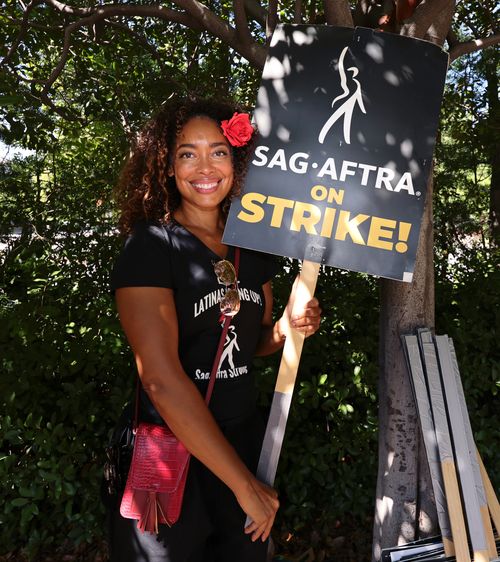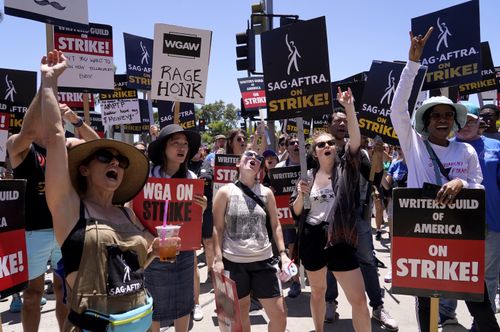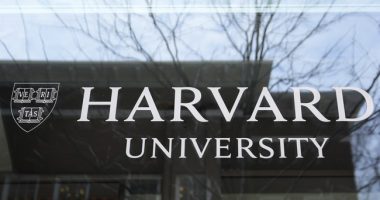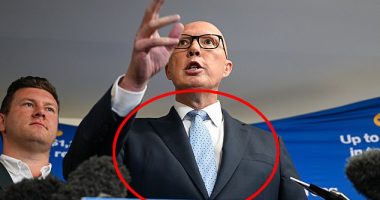Hollywood actors have reached a tentative agreement with the major film and television studios to end a strike, the actors union announced on Wednesday (USA time).
The Alliance of Motion Picture and Television Producers, which represents the studios, had been negotiating with the union off and on throughout the year to reach a deal.

“In a unanimous vote this afternoon, the SAG-AFTRA TV/Theatrical Committee approved a tentative agreement with the AMPTP bringing an end to the 118 day strike,” the actors union said in a Wednesday night announcement (Thursday morning AEDT).
The strike will officially end at midnight, the union said.
The studios have not yet publicly acknowledged the resolution.
Terms of the deal, which still needs to be ratified by the union’s members before it can take effect, were not immediately disclosed.
But union president Fran Drescher posted some highlights on Instagram Wednesday night.
Drescher also thanked the AMPTP “for hearing us and meeting this moment.”
The agreement sets the stage for the roughly 160,000 actors represented by SAG-AFTRA to return to work after they walked off the set on July 14, joining the writers’ guild in a historic double strike against the studios – the first time the writers and actors had simultaneously been on strike in more than 60 years.

While the writers’ strike was resolved in September, production has remained shuttered as the actors continued to strike and negotiate their contract.
At the centre of both standoffs is the rise of artificial intelligence, which threatens to upend the entire entertainment business, and became one of the final and most elusive issues the actors and studios sought agreement on.
But a person familiar with the matter told CNN that the studios have agreed to adjust language on AI, appearing to resolve that outstanding issue, at least.
Still, the deal could face challenges getting ratified.
An online petition signed by more than 5,000 members recently urged the union to take a hard line in negotiations toward a final deal, saying they would not agree to a deal that did not meet the demands laid out at the start of the strike.
“We have not gone without work, without pay, and walked picket lines for months just to give up on everything we’ve been fighting for. We cannot and will not accept a contract that fails to address the vital and existential problems that we all need fixed.”

Long road to a resolution
A deal did not come easily – or quickly.
After several fits and starts, the striking actors had resumed negotiations on October 2 with producers after a long time away from the bargaining table.
The announcement to restart talks came a day after leaders of the Writers Guild of America voted to authorise its members to return to work following their tentative agreement reached September 24 between union negotiators and Hollywood’s studios and streaming services.
Read Related Also: Three people killed in light plane crash in Queensland
But the actors’ contract negotiations didn’t last long, breaking down on Oct 11 before returning later in the month.
By the end of October, it appeared the actors’ strike was approaching its final scene. SAG-AFTRA and AMPTP had made significant progress in negotiating sessions, arriving at tentative understandings on key components of a potential deal, CNN reported.
This past weekend, the studios said they delivered the union their “last, best & final offer.”
But the union said in a message to its members that there are several “essential items” that the two sides have yet to reach agreement on, such as the use of AI.
Despite growing pressure to the reach a deal, 5,000 SAG-AFTRA members signed an online petition urging a hard line in negotiations toward a final agreement, saying they would not agree to a deal that did not meet the demands laid out at the start of the strike.
Hollywood’s most famous stars were eager to get back on set.
George Clooney, Tyler Perry and other A-list actors offered to pay millions more in union dues to help end the actors’ strike, a source with knowledge of the proposal previously told CNN.

Smiling serial killer holds unique place in Australian crime records
Clues from the writers’ strike
The WGA deal ramped up pressure for SAG-AFTRA to reach an agreement along the same lines. SAG-AFTRA joined the picket line a little over two months after the Writers Guild went on strike.
Their contract, which will expire in May 2026, includes pay increases, better benefits, protections against the studios’ use of artificial intelligence, guarantees for streaming compensation, longer-duration employment terms and other perks.
SAG-AFTRA’s demands were similar to WGA’s, particularly regarding artificial intelligence and residuals payments from streaming services for their work. WGA’s ratified contract included assurances that AI cannot write or rewrite literary material and will require AI-generated materials to be disclosed to writers.
Both actors and writers alike believe AI poses an existential threat to their livelihoods.
A major sticking point during negotiations was SAG-AFTRA’s demands for an 11 per cent wage increase in the first year of the proposed contract term, while the studios had only agreed to a 5 per cent pay raise.
Work for many writers resumed promptly.
Late night’s biggest hosts – Jimmy Kimmel, Jimmy Fallon, Stephen Colbert, John Oliver and Seth Meyers – returned to the air quickly after the writers strike ended.
But Hollywood actors have not appeared on their shows to promote their movies during the actors strike.
The Hollywood strikes have been costly, with a nationwide economic impact of at least $7 billion ($US5 billion), according to economists.
The impacts have gone beyond production; it’s affected local businesses and restaurants, as well as makeup artists and custodians.








